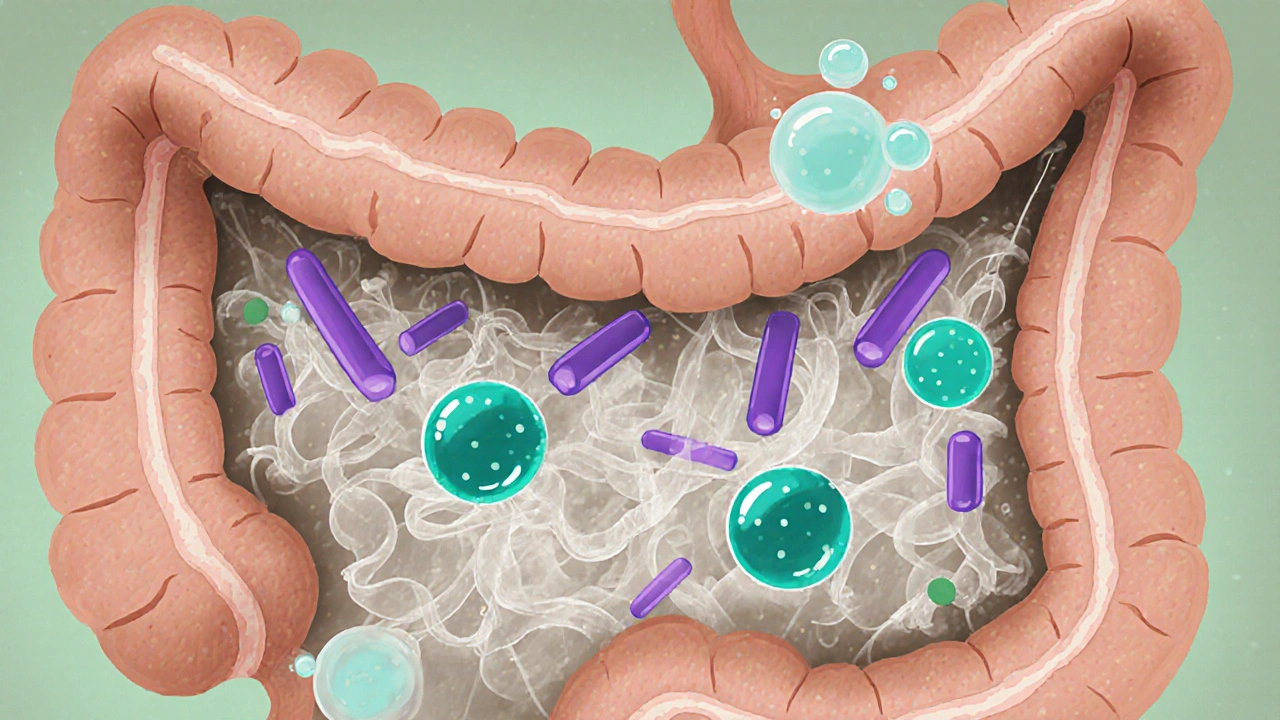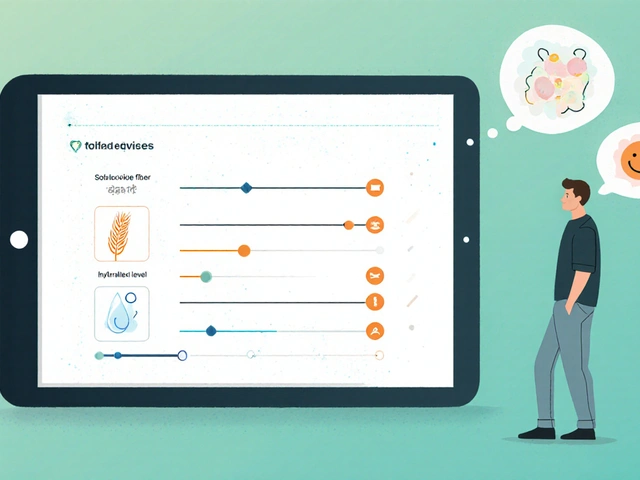Fiber Intake & Gas Calculator
Estimated Gas Impact
Enter your values and click "Calculate Gas Potential"
Key Takeaways
- Fiber feeds gut bacteria, which can create gas-but the type and amount matter.
- Soluble fiber is more fermentable, often causing more flatulence than insoluble fiber.
- Gradually increasing fiber, staying hydrated, and pairing fiber with probiotic foods can keep gas under control.
- A daily intake of 25‑30g for women and 30‑38g for men supports regular bowel movements without excessive bloating.
- Choosing low‑fermentable fiber sources (e.g., oats, carrots) works well for sensitive stomachs.
What Fiber Actually Is
When you hear the word Fiber is the indigestible portion of plant foods that passes through the gastrointestinal tract largely unchanged, think of it as the plant’s structural skeleton. It isn’t a nutrient that provides calories, but it does wield huge influence over how the gut functions.
Flatulence: The Gas Side of Digestion
Flatulence is the release of gas from the digestive tract through the rectum. The gas comes from three main sources: swallowed air, chemical reactions during digestion, and the bacterial fermentation of undigested carbohydrates-including many types of fiber.
How Fiber Triggers Gas
The gut harbors trillions of microbes, collectively called the gut microbiota is the community of bacteria, fungi, and viruses living in the intestines that help break down food components we can’t digest ourselves. When you eat fiber, these microbes ferment it, producing short‑chain fatty acids (SCFAs) like acetate, propionate, and butyrate-great for colon health-but also gases such as hydrogen, methane, and carbon dioxide.
Not all fibers are equal. The two broad families-soluble and insoluble-behave differently in the gut:
Soluble vs. Insoluble Fiber: A Quick Comparison
| Attribute | Soluble Fiber | Insoluble Fiber |
|---|---|---|
| Water Solubility | dissolves to form a gel‑like substance | remains largely unchanged in water |
| Fermentability | Highly fermentable → more SCFA and gas | Low fermentability → less gas |
| Primary Benefits | Lowers cholesterol, moderates blood glucose | Increases stool bulk, speeds transit |
| Common Sources | Oats, beans, apples, psyllium | Whole wheat, nuts, seeds, vegetable skins |
| Typical Gas Production | Moderate‑to‑high | Low |
Why Some People Get More Gassy Than Others
Individual differences in prebiotic fiber is a type of soluble fiber that selectively fuels beneficial gut bacteria consumption, microbial composition, and transit speed all shape gas output. For example, people whose gut hosts more gas‑producing bacteria (like certain Bacteroides species) will notice more bloating after a bowl of beans.
Age, medication use (e.g., antibiotics), and overall diet also tip the balance. A high‑fat, low‑fiber diet can starve the microbiota, leading to overgrowth of gas‑producing microbes when fiber is finally re‑introduced.

Managing Flatulence While Reaping Fiber’s Benefits
- Start Slow: Add 5‑10g of fiber per day for the first week, then increase gradually. This lets microbes adapt without a sudden gas surge.
- Stay Hydrated: Water helps soluble fiber expand into a gel, reducing the chance that it ferments unchecked.
- Mix Fiber Types: Pair soluble sources (e.g., oatmeal) with insoluble ones (e.g., brown rice) to balance bulking and fermentability.
- Chew Thoroughly: Mechanical breakdown reduces the amount that reaches the colon intact, which can lessen fermentation.
- Include Probiotic Foods: Yogurt, kefir, and fermented vegetables introduce helpful bacteria that can compete with gas‑producing strains.
- Mind Portion Sizes: Large servings of beans or lentils can overwhelm even a tolerant gut. Split them across meals.
- Consider Low‑FODMAP Alternatives: If you’re very sensitive, choose low‑FODMAP vegetables (e.g., zucchini, carrots) and fruits (e.g., strawberries) that provide fiber with less fermentable carbs.
Recommended Daily Fiber Intake
Guidelines from nutrition authorities (e.g., the Australian Dietary Guidelines) suggest 25g per day for adult women and 30g for adult men. However, personal tolerance varies. Some people feel comfortable at 15g of mostly insoluble fiber, while athletes may thrive on 35‑40g of mixed fiber to aid recovery and gut health.
Best Food Sources for a Balanced Fiber Boost
- Oats: Rich in β‑glucan, a soluble fiber that supports cholesterol control but can increase gas if over‑eaten.
- Legumes (beans, lentils): High in both soluble and insoluble fiber; start with a quarter‑cup cooked portion.
- Root Vegetables (carrots, sweet potatoes): Provide mainly insoluble fiber and are generally easy on the belly.
- Whole Grains (brown rice, quinoa): Offer a mix of fiber types and micronutrients.
- Fruit with Skin (apples, pears): Contain pectin (soluble) and cellulose (insoluble). Eat them raw for the full fiber punch.
When to Consider Fiber Supplements
If whole foods aren’t enough, a supplement can fill the gap. psyllium husk is a soluble, gel‑forming fiber commonly used in supplements is popular because it adds bulk without a lot of fermentable carbs, making it a good option for people prone to gas.
Read the label: aim for 5‑10g of fiber per serving, and start with half a dose mixed in water. Too much at once can cause bloating, the very problem you’re trying to avoid.
Potential Pitfalls and How to Avoid Them
- Over‑loading the Colon: Jumping from 0 to 30g of fiber in a day often leads to excessive gas, cramping, and even constipation.
- Insufficient Fluids: Fiber draws water; without enough liquid you risk hard stools and discomfort.
- Ignoring Individual Tolerance: Some people react strongly to specific fibers like inulin. Keep a food diary to spot culprits.
- Relying Solely on Supplements: Whole foods provide pre‑biotics, vitamins, and minerals that supplements lack.
Quick Checklist for a Gas‑Friendly Fiber Routine
- Add 5g fiber per day for the first week.
- Drink at least 2L of water daily.
- Include a probiotic food at each meal.
- Rotate soluble sources (oats, fruit) with insoluble sources (whole grains, nuts).
- Track symptoms; adjust type or amount if flatulence spikes.
Frequently Asked Questions
Can fiber cause constipation?
Yes, but only when you increase fiber without enough water or when you consume large amounts of low‑fermentable (insoluble) fiber that speeds transit too quickly. The key is to balance both types and stay hydrated.
Which fiber is best for reducing bloating?
Low‑fermentable insoluble fiber, such as wheat bran or carrot sticks, tends to add bulk without a lot of gas. Pair it with a small amount of soluble fiber for overall health.
How long does it take for the gut to adjust to more fiber?
Most people notice a reduction in gas after 7‑10days of steady, moderate fiber intake, as the microbiota composition shifts toward more efficient fermenters.
Is it okay to take fiber supplements every day?
Daily use is fine if you follow the dosage instructions and keep up with water intake. However, prioritize whole‑food sources for a broader nutrient profile.
Do probiotics really help with fiber‑induced gas?
Probiotics can introduce strains that consume excess hydrogen or produce less methane, which can neutralize some of the gas produced during fiber fermentation.
Understanding the dance between fiber and gut bacteria gives you the power to enjoy a healthier digestive system without the embarrassment of constant flatulence. Adjust slowly, stay hydrated, and listen to your body-your gut will thank you.



Abby Elizabeth
October 4, 2025 AT 04:00Ugh, all this fiber talk just makes me feel bloated and dramatic.
Mark Haycox
October 8, 2025 AT 19:06Honestly this whole fiber calculator is a joke – who needs some computer to tell you you’re gassy? It’s just another way for the “experts” to push their agenda and make us feel stupid for eating vegetables.
Michael Taylor
October 13, 2025 AT 10:13Reading through this post reminded me why I love fiber, because it’s a powerhouse of gut health; it feeds beneficial bacteria, but it also has a mischievous side that can turn your stomach into a symphony of farts. First, the distinction between soluble and insoluble fiber is crucial, as the former tends to ferment more, producing gases like hydrogen and methane, while the latter mostly adds bulk and speeds transit. Second, the gradual increase recommendation is spot on, because a sudden jump from 0 to 30 grams can overwhelm even the most resilient microbiome, leading to uncomfortable bloating and flatulence. Third, hydration is emphasized rightly; water allows soluble fiber to form a gel that slows fermentation and eases passage. Fourth, pairing fiber with probiotic foods introduces helpful strains that can compete with gas‑producing microbes, effectively reducing the odor and volume of gas. Fifth, the low‑FODMAP alternatives are a lifesaver for those with irritable bowel syndrome, as they provide fiber without the heavy fermentable load. Sixth, the suggestion to chew thoroughly may sound obvious, but thorough mastication truly reduces the particle size, limiting the amount that reaches the colon unchanged. Seventh, the article’s checklist, with its simple bullet points, offers a practical roadmap that many readers can follow. Eighth, the inclusion of fiber supplements like psyllium husk acknowledges that not everyone can meet their goals through whole foods alone, yet it warns against over‑dosage, which is wise. Ninth, the potential pitfalls section correctly points out that insufficient fluids with high fiber can cause constipation, a paradoxical outcome. Tenth, the discussion on individual variability in gut microbiota reminds us that genetics, diet history, and antibiotic use all shape our gas production. Eleventh, the emphasis on listening to one's body cannot be overstated; self‑monitoring helps tailor fiber type and amount. Twelfth, the article balances scientific detail with actionable advice, making it accessible to both novices and seasoned health enthusiasts. Thirteenth, the tone stays encouraging rather than guilt‑inducing, which likely improves adherence. Fourteenth, the clear tables and headings break down complex information into digestible chunks, pun intended. Fifteenth, overall this comprehensive guide empowers readers to harness the benefits of fiber while keeping flatulence in check, which is exactly what we need in today’s health‑focused world. Finally, keep in mind that consistency is key – small daily tweaks lead to lasting improvements.
Troy Brandt
October 18, 2025 AT 01:20Great breakdown! I’d add that keeping a simple food journal can help pinpoint which fiber sources trigger the most gas for you, so you can adjust accordingly.
Barbra Wittman
October 22, 2025 AT 16:26Well, look at us, all dazzling over a topic that most of us pretend not to think about until someone lets one rip in a quiet elevator. I suppose it’s comforting to know that the very thing that keeps us regular can also double as a personal soundtrack for awkward moments. The article does a decent job of separating soluble from insoluble fiber, but let’s be honest – most of us can’t even tell the difference between oat bran and wheat bran at the grocery aisle. Still, the recommendation to “stay hydrated” is practically a mantra for any diet trend, yet we all forget to drink water when we’re busy scrolling through posts like this. The reassurance that “gradual increase” prevents gas is nice, but the reality is many of us forget to read labels and end up with a bowl of beans and a side of regret. I appreciate the checklist for its simplicity, though I’m still skeptical about the “probiotic foods” line – does a spoonful of yogurt truly outweigh a plate of lentils? In any case, kudos to the author for tackling a subject most people would rather avoid discussing in polite company.
Gena Thornton
October 27, 2025 AT 07:33You’re right, the grocery aisle can be confusing, but focusing on the fiber content listed per serving can make a big difference; just look for the “dietary fiber” line on the nutrition facts.
Lynnett Winget
October 31, 2025 AT 22:40Imagine your gut as a bustling marketplace where fiber is the friendly vendor handing out tasty treats to the bacterial shoppers – some love the sweet soluble delights, while others prefer the crunchy insoluble goodies, and together they keep the town lively without too much commotion.
Amy Hamilton
November 5, 2025 AT 13:46Fiber, in its quiet steadfastness, offers a lesson in balance: it reminds us that nourishment need not be a sacrifice of comfort, but rather a harmonious dialogue between our bodies and the plants that sustain us.
Lewis Lambert
November 10, 2025 AT 04:53Beautifully said! Embracing that balance can indeed transform our relationship with food, turning every bite into an act of mindful care.
Tamara de Vries
November 14, 2025 AT 20:00hey guys just wanted to say that i started adding a little oats to my breakfast and i feel less bloated now lol thanks for the tips
Jordan Schwartz
November 19, 2025 AT 11:06I’m glad to hear it’s working for you, Tamara – small changes often lead to big improvements in how we feel day to day.
Nitin Chauhan
November 24, 2025 AT 02:13Fiber is essential keep moving drink water
Angelo Truglio
November 28, 2025 AT 17:20!!! THIS IS THE ABSOLUTE TRUTH ABOUT FIBER !!! If you think you can just eat a loaf of whole‑grain bread and expect no side effects, you’re living in a fantasy land!!! The gut microbiome is a war zone and every gram of soluble fiber is a soldier marching straight into battle, producing gas like artillery fire!!! Hydration? YOU BET THAT’S THE SUPPLY LINE!!! WITHOUT IT, THE ENTIRE ARMY COLLAPSES!!! And don’t even get me started on “gradual increase” – that’s just a polite way of saying “prepare for the inevitable explosions”!!! 😤
Dawn Midnight
December 3, 2025 AT 08:26While your enthusiasm is noted, punctuation should be used sparingly; excessive exclamation marks dilute the impact of your argument.
frank hofman
December 7, 2025 AT 23:33actually i think all this fiber hype is overblown 😂 people can be fine without counting grams